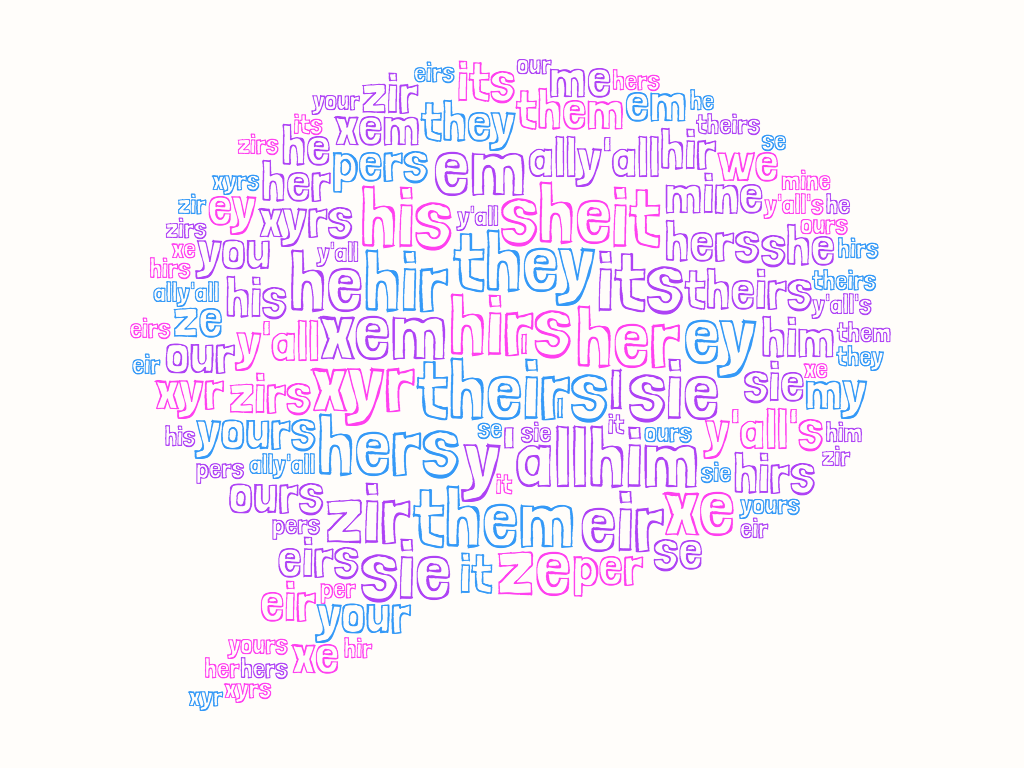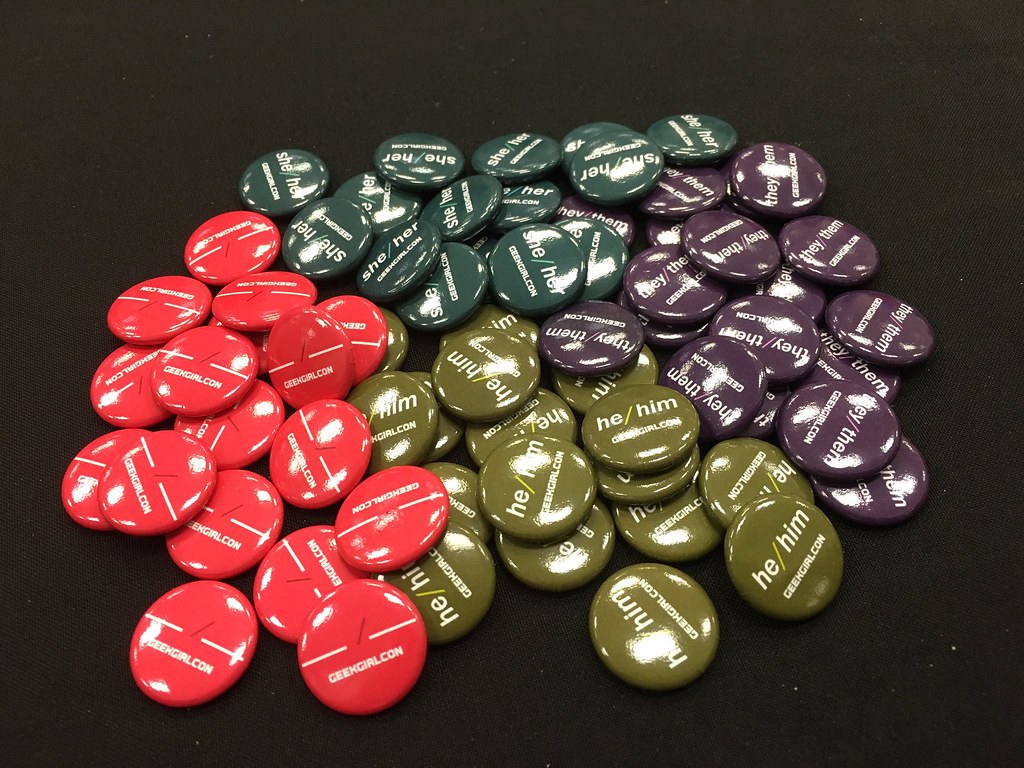Download a PDF copy of our Pronouns Guide here!
What is a pronoun?
A pronoun is a word that replaces a noun in a sentence to eliminate the awkwardness of repeating the same noun over and over again.
There are many different types of pronouns, each serving a different purpose. Personal or gender pronouns are used as a substitute for a person’s name. For more information check out www.mypronouns.org.
How do I know what personal/gender pronouns someone uses?
Easy, by asking them! (They also may tell you.)

How do I ask what pronouns someone uses?
It can be as simple as asking “What pronouns do you use?” or “What are your pronouns?”.
It’s also great to introduce yourself with your own pronouns (and not just when talking with someone you think might be trans, nonbinary, or gender expansive!) You can do that like this:
“Hi, I’m ______. My pronouns are ______. What’s your name and what pronouns do you use?”
Why is it important to use the correct pronoun?
Using the correct pronoun creates safer and more inclusive spaces for people to be themselves knowing that others are going to respect their identity. Referring to someone with the wrong pronoun can make them feel disrespected, invalidated, dismissed, alienated and/or dysphoric.
Asking AND correctly using someone’s pronoun is one of the most basic ways to respect someone and their gender identity. While it may seem obvious to you what someone’s pronouns are, you can never know what pronouns someone uses by just looking at them. (Unless they’re wearing a name tag or a pin that tells your their pronouns, of course!)

What if someone uses more than one set of pronouns?
Some people use more than one set of pronouns. Generally, this is because they feel their gender identity isn’t fully affirmed by one set of pronouns and any of the pronouns they use can be used interchangeably. Sometimes people use different sets of pronouns in different settings or situations (i.e. personal life vs. work or school). If you’re not sure how the person’s pronouns should be used, ask them!
You can learn more in this article from Them: How To Affirm the People in Your Life Who Use Multiple Sets of Pronouns.
What if I make a mistake?
We all make mistakes. Apologize genuinely, correct yourself and move on. If you only stay in apology mode, you are making the situation about you, and that’s not ok. Acknowledge the mistake and adjust your language.
Besides using someone’s pronouns correctly, what are other ways I can be supportive?
Good question! There are a few really easy ways to start using pronouns in affirming and supportive ways:
– Introduce yourself using your pronouns! “Hey there, I’m _____. My pronouns are ___/___/___.” This is a great way to normalize sharing and asking for pronouns, especially in group settings.
– Add your pronouns to your email signature, your social media accounts , your video chat name (i.e., Zoom ID), and your nametag when you’re at an event.

Common Pronouns (and how to use them!)
You can download a PDF of this pronoun chart here!
Please keep in mind that this is not an exhaustive or comprehensive list of personal and gender pronouns. Some people may also use multiple sets or combinations of pronouns. Some people don’t use pronouns at all and you should just use their name when referring or speaking to them. These are all general pronunciations, if someone tells you differently, you should always default to respecting the way they use their pronouns!
She / Her / Hers / Herself
Pronunciation: (shee) / (hur) / (hurs) / (hurself)
Examples: She wants a pet. / Give her the book. / Her favorite color is red. / That pen is hers. / She is looking at herself.
He / Him / His / Himself
Pronunciation: (hee) / (him) / (his) / (himself)
Examples: He wants a pet. / Give him the book. / His favorite color is red. / That pen is his. / He is looking at himself.
They / Them / Their / Theirs / Themself
Pronunciation: (they) / (them) / (theirs) / (themself)
Examples: They want a pet. / Give them the book. / Their favorite color is red. / That pen is theirs. / They are looking at themself.
[Please note that although “they” pronouns here are singular and refer to an individual, the verbs are generally conjugated the same as with the plural “they” (e.g. “they are”). But if someone tells you otherwise, respect their pronoun usage!]
Ze* / Hir / Hirs / Hirself *(sometimes also spelled Sie or Zie)
Pronunciation: (zee) / (heer) / (heers) / (heerself)
Examples: Ze wants a pet. / Give hir the book. / Hir favorite color is red. / That pen is hirs. / Sie is looking at hirself.
Xe / Xem / Xyr / Xyrs / Xyrself
Pronunciation: (zee or zey*) / (zem) / (zeer) / (zeers) / (zeerself)
Examples: Xe wants a pet. / Give xem the book. / Xyr favorite color is red. / That pen is xyrs. / Xe is Looking at xyrself.
(*If someone doesn’t tell you xyr pronouns verbally, you should ask xem how xe pronounces it.)
Ze / Zim / Zir / Zirs / Zirself
Pronunciation: (zee) / (zim) / (zeer) / (zeers) / (zeerself)
Examples: Ze wants a pet. / Give zim the book. / Zir favorite color is red. / That pen is zirs. / Ze is looking at zirself.
E or Ey / Em / Eir / Eirs / Eirself or Emself
Pronunciation: (e) or (ay) / (em) / (ear) / (ears) / (earself)
Examples: Ey wants a pet. / Give em the book. / Eir favorite color is red. / That pen is eirs. / Ey is looking at eirself.
Examples: E wants a pet. / Give em the book. / Eir favorite color is red. / That pen is eirs. / Ey is looking at emself.
Per / Per / Pers / Perself
Pronunciation: (per) / (per) / (pers) / (perself)
Examples: Per wants a pet. / Give per the book. / Per favorite color is red. / That pen is pers. / Per is looking at perself.
Fae / Faer / Faers / Faerself
Pronunciation: (fay) / (fair) / (fairs) / (fairself)
Examples: Fae wants a pet. / Give faer the book. / Faer favorite color is red. / That pen is faers. / Fae is looking at faerself.
Ve / Ver / Vers / Verself
Pronunciation: (vee) / (vur) / (vurs) / (vurself)
Examples: Ve wants a pet. / Give ver the book. / Vis favorite color is red. / That pen is vers. / Ver is looking at verself.

